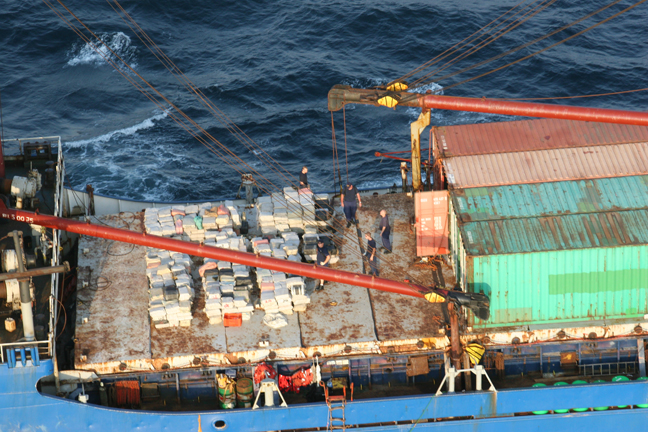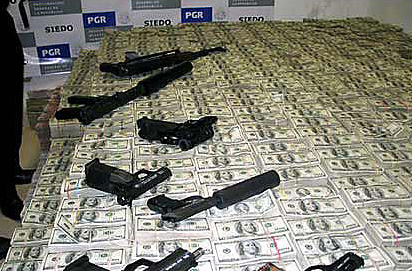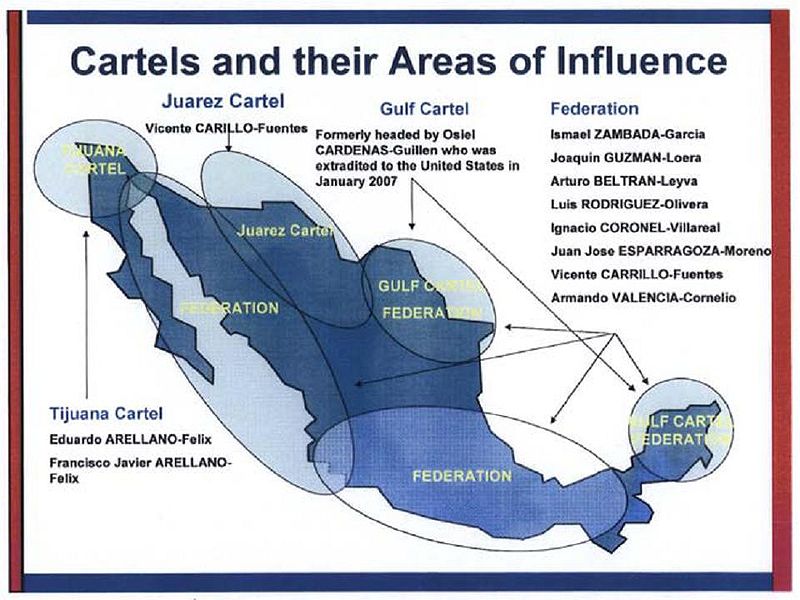
Panamanian motor vessel Gatun during the largest drug bust in United States Coast Guard history (20 tons of cocaine) off the Coast of Panama, United States Coast Guard, public domain
Drug Trafficking
International drug trafficking is a often discussed global issues, and is a major problem in international relations. In this article, we shall examine drug trafficking as it relates to transnational crime. We shall discuss what is drug trafficking, the different types of drug that are trafficked throughout the world, as well as look at domestic politics of countries such as Afghanistan and Mexico with regards to drug trafficking. We shall also discuss different arguments as to stoping the drug trade and drug trafficking. Then, we will list a number of scholarly books and academic references on the topic of drug trafficking.
What is Drug Trafficking?
The United Nations Office of Drugs and Crime (2014b) explains that “[d]rug [t]rafficking is a global illicit trade involving the cultivation, manufacture, distribution and sale of substances which are subject to drug prohibition laws.” Drug trafficking operates throughout the world, and involves many actors, including transnational criminal organizations.
There are many drugs that are trafficked throughout the world. When people speak about the drug trade, they usually talk about drugs such as cocaine, heroin, marijuana, along with prescription drugs, among other drugs. In this article, we shall discuss drug trafficking with regards to heroin, cocaine, and marijuana.
Heroine
Regarding the drug trafficking of heroin, it is said that “[a]t current levels, world heroin consumption (340 tons) and seizures represent an annual flow of 430-450 tons of heroin into the global heroin market” (UNODC, 2014b). A large percentage of this heroin comes from Myanmar, as well as Laos. But the majority of heroin production in the world originates from the Afghanistan opium market. In fact, the vast majority of opium from Afghanistan is not consumed domestically, but rather is trafficked internationally (UNODC, 2014b).
It is said that there are many routes for the heroin to be trafficked from Afghanistan. For example, according to the UNODC (2014b), “The Balkan and northern routes are the main heroin trafficking corridors linking Afghanistan to the huge markets of the Russian Federation and Western Europe. The Balkan route traverses the Islamic Republic of Iran (often via Pakistan), Turkey, Greece and Bulgaria across South-East Europe to the Western European market, with an annual market value of some $20 billion.”
Cocaine
Cocaine is also one of the other most trafficked drugs in the world. According to the United Nations Office of Drug and Crime (2014a), “[w]hile cocaine manufacture and trafficking have had a serious impact in the Western hemisphere, there are indications that overall global availability of cocaine has fallen. The estimated net area under coca bush cultivation as of 31 December 2012 was the lowest since the beginning of available estimates in 1990: 133,700 hectares, a decline of 14 per cent from the estimate for 2011” (UNODC, 2014a). Regarding the drug, Cocaine is primarily produced in South American countries such as Columbia, Bolivia, and Peru. Most of the cocaine drug trafficking is from these countries to end destination countries such as the United States and Europe. Regarding Europe, cocaine drug trafficking can go through the Caribbean, or through West Africa into Europe (Haken, 2011).
Marijuana
Marijuana (or Cannabis) is another drug that has global use, and is said to be a $6 billion dollar a year industry (Likmeta, 2013). In fact, “Cannabis remains the most widely produced and consumed illicit substance globally” (UNODC, 2011). According to the UNODC (2011) 2009 figures, “between 2.8% and 4.5% of the world population aged 15-64, corresponding to between 125 and 203 million people, had used cannabis at least once in the past year” (175).
There are a number of places in the world where Marijuana is produced. It is said that “Cannabis is produced in practically every country of the world, making it the most widely produced illicit drug (UNODC, 2011), although the countries that produce marijuana resin are much less than those that produce the marijuana herb (UNODC, 2014a). Cannabis herb is mostly produced for domestic or regional markets, whereas cannabis resin is trafficked over larger distances. The major countries identified as sources by the cannabis resin consumer markets are Afghanistan, Morocco, Lebanon and Nepal/India” (UNODC, 2011: 189). For example, the marijuana production in Afghanistan is beginning to rival the opium production in the country (UNODC, 2011). There are also other countries and cities growing marijuana (UNODC, 2011). For example, one of the cities with a very high level of marijuana production as related to its population in Europe, for example, is Gjiokastra, in Albania. Here, the majority of those in the city are growing marijuana (Likmeta, 2013).
Drug Trafficking in Mexico
There have also been high levels of violence in Mexico due to drug trafficking and competing criminal enterprises vying for the drug market; more and more organized criminal groups are trying to control not only territory, but also drug trafficking routes (Robles, Calderon, & Magaloni, 2013). But not only is there violence, but this violence in the forms of murders have increased drastically in recent year; drops in the murder rate in Mexico from 2000-2007 (with a per capita rate of 25 percent) have doubled to 50 percent in the years 2007-2009 (Sistema Nacional de Seguridad Publica and Consejo Nacional de Publacion, 2010, in Kilmer & Caulkins, 2010), with “[o]ver 50,000 drug-trafficking-related deaths…registered by 2011. The vast majority of these deaths were caused by confrontations between drug cartels competing for control of routes and locations strategic for trafficking drugs to the world’s largest market: the United States” (Robles, Calderon, & Magaloni, 2013: 2). Thus, it is important to understand the actions taking place domestically in Mexico in order to know the effect of the drug trade in the country, as well as the effects of drug trafficking on other countries such as the United States.
Scholars argue that there are three primary reasons as to why we have seen such an increase in violence in the country: “exogenous changes in the narcotics market, including above all the relative success of Columbia at counter narcotics operations and drug seizures (Castillo & Mejia, 2012); the increased fragmentation of drug cartels into numerous smaller organizations and criminal cells; and the militarized fight against drugs and drug trafficking that began during the administration of President Felipe Calderon (Guerrero Gutierrez, 2011a; Dell, 2012; Calderon, et al, 2013, in Robles, Calderon, & Magaloni, 2013: 2).
As we see in the graph below, there are a number of drug trafficking and drug trade cartels in Mexico. These groups are all active in the drug trafficking business, and want to control drug territory (Robles, Calderon, & Magaloni, 2013), but have different positions on other activities such as kidnapping. This can be seen when comparing El Cartel de Tijuana, where they “underwent an internal split between two factions, one led by Teodoro Garcia Simental (alias El Teo) that apparently favored kidnappings in Tijuana, and the other faction, led by Luis Fernando Sanchez Arellano (alias El Ingeniero–the Engineer) with strong political and economic connections in the city, that wanted to focus primarily on drug trafficking and demanded the reduction of kidnappings as the main victims of this crime were businessmen” (3). Robles, Calderon, and Magaloni (2013) go on to say that “El Ingeniero feared that kidnappings were attracting too much attention from the government and were contributing to the destruction of businesses” (3). In fact, this cartel was not the only one to have shifts regarding their activities. For example, the cartel group La Familia Michocana began by focusing on protecting individuals from drug traffickers, but “[t]he group over time transformed into a criminal gang that increasingly began using violence against the population and widespread extortion against citizens” (3). One also sees this with the Zetas in the country (Robles, Calderon, & Magaloni, 2013).
Thus, there is a high level of insecurity in Mexico given the rise of the different drug cartels. What makes it worse is that a number of officers are said to be working with drug cartels, which increases citizens concerns about the government being able to protect them (Robles, Calderon, & Magaloni, 2013).
Countries face security concerns with regards to drug trafficking issues, particularly if there is significant drug activity in or around its borders. This is one of the main international relations issues between the United States and Mexico, namely that there have been incidents of fighting over the drug trade to come into United States territory. However, as Kilmer and Caulkins (2010) explain, “while spillover violence does have important security implications for those living and working north of the border, the threat might have been exaggerated and pales in comparison to the lawlessness that prevails parts of Mexico” (1).

$205 Million drug money seized by the Mexican Police and the Drug Enforcement Administration in Mexico city — largest single drug cash seizure in history (2007), Drug Enforcement Agency, public domain
Ways to Stop Drug Trafficking
There have been a number of proposed (and applied) methods in the fight against drug trafficking. These have included the legalization of drugs, the importance of domestic anti-drug campaigning, as well as the reduction in the demand side of the drug market. In fact, many governments do take one of two approaches, either they focus on reducing supply, or reducing demand of drugs.
Reducing the Supply of Drugs
The United States has been one of the most active countries in the world with regards to reducing the supply of drugs in the international system. In fact, the United States was highly involved in international conferences on the issue of reducing the supply of drugs as early as the early 1900s. For example, The United States, along with China, as well as other states, came together in the first decade following the 20th century in attempts to reduce the supply of drugs. And out of an international conference in 1909 came The International Opium Commission. And although not very effective, it did at least bring states together to further talk about drugs within international relations. And two years later, “[t]he Hague Convention of 1911 broadened the drug-fighting effort by including morphine and cocaine and committed the signatories to reducing their production and distribution of drugs” (Payne, 2013: 259). However, even this was criticized for not being able to effectively act on drugs. But did not stop the international community from building international law against drug distribution and drug trafficking. Other legislation included the Harrison Act in the year 1914, the Opium Control Board by the League of Nations, , as well as United Nations actions that include the International Conference on Drug Abuse and Illicit Traffic in the year 1987, as well as the UN Convention Against Illicit Traffic in Narcotic Drugs and Psychotropic Substances” (Payne, 2013: 259). The United Nations also put forward the International Drug Control Program (Payne, 2013: 259).
Reducing the Demand of Drugs
Some have believed that in order to stop the supply of drugs through drug trafficking, one must reduce the demand for the drugs. In fact, this has been an argument by various leaders in Latin America, namely that “if the U.S. population did not consume such large quantities of illegal drugs–if there not so many American drug addicts and users–then Latin America and Caribbean countries would not produce such large quantities of illegal drugs like marijuana, cocaine, and heroin for export and the region would not be plagued by the powerful and well-financed drug trafficking organizations…” (Bagley, 2012: 1). However, it has to be remember that drug trafficking and drug use is world problem, as we have seen a rise of cocaine use in European Union countries in the past ten years, from “4.3 to 4.75 million cocaine users, which represent 30 percent of the worldwide consumption in cocaine” (Bagley, 2012: 2). Nevertheless, the United States has devoted billions to fight the use of drugs within the country. The United States have also tried to work with other countries such as Columbia with the Plan Columbia program, which aimed to stop supply of cocaine from Columbia (Payne, 2013). However, US efforts have been highly criticized, both for not being effective in stopping drugs entering into the US (Payne, 2013), as well as criticizing the program as disproportionately affecting African Americans in the United States with regards to arrests and prison sentences, despite the fact that there are more Caucasian Americans and that “both groups use and sell drugs at similar rates” (Gunja, 2003: 1). Other countries have taken a different approach to that of the United States. For example, “Europeans concentrate on treating drug addiction more as a medical problem while supporting efforts to reduce drug supplies. Harm reduction approaches acknowledge the weaknesses of the war-on-drugs approach” (Payne, 2013: 260).
Legalizing Drugs in Order to Reduce Drug Trafficking
Others have suggested that in order to reduce drug trafficking, the best approach is to actually legalize drugs. As Beau Kilmer and Jonathan P. Caulkins (2010) discuss this issue with regards to drug trafficking and the drug trade in Mexico, they explain that “[t]he consequences of Mexico unilaterally legalizing drug production and distribution are fairly easy to foresee. Legalization would limit DTO revenues from drug distribution in Mexico to revenues only derived from evading any associated taxes and regulations” (2). But this approach would need international patterns, as they argue that without similar US policies on the legalization of drugs, then drug cartels could merely traffic the drugs themselves into the United States, thus bypassing any taxation that the government in Mexico would place on the drugs (Kilmer & Caulkins, 2010).
Scholarly Books on Drug Trafficking
Charles F. Levinthal, Drugs, Society, and Criminal Justice
Howard Rahtz, Drugs, Crime and Violence: From Trafficking to Treatment.
David Mares, Drug Wars and Coffeehouses: The Political Economy of the International Drug Trade
Arthur Benavie, Drugs: America’s Holy War
References
Calderon, G., Diaz-Cayeros, A., Magaloni, B., & Robles, G. (2013). The Temporal and Spatial Dynamics of Violence in Mexico, Working Paper, Stanford University
Castillo, J.C. & Mejia, D., (2012). Illegal Drug Markets and Violence in Mexico: The Causes Beyond Calderon. Mimeo, Universidad de los Andes.
Dell, M. (2012). Trafficking Networks and the Mexican Drug War, Job Market Paper, Economics Department. Massachusetts Institute of Technology.
Guerrero Gutierrez, E. (2011a). La raiz de la violencia, Nexos, 1 junio 2011. Available Online: http://www.nexos.com.mx/?P=leerarticulo&Article=2099328
Gunja, F. (2003). Race and the War on Drugs. American Civil Liberties Union Position Paper. May 2003. Available Online: https://www.aclu.org/files/FilesPDFs/ACF4F34.pdf
Kilmer, B. & Caulkins, J.P. (2010). Reducing Drug Trafficking Revenues and Violence in Mexico. RAND Occasional Paper. Available Online: http://www.rand.org/content/dam/rand/pubs/occasional_papers/2010/RAND_OP325.pdf
Likmeta, B. (2013). Europe’s Marijuana Capital Isn’t Amsterdam. Global Post. August 16, 2013. Available Online: http://www.globalpost.com/dispatch/news/regions/europe/130815/europe-marijuana-capital-lazarat-albania
Payne, R. (2013). Global Issues. New York, New York. Pearson.
Robles, G., Calderon, G. & Magaloni, B. (2013). The Economic Consequences of Drug Trafficking Violence in Mexico. Economic Consequences of Drug Trafficking Violence, Poverty and Governance, Stanford University. Available Online: http://fsi.stanford.edu/sites/default/files/RoblesCalderonMagaloni_EconCosts5.pdf
Sistema Nacional de Seguridad Publica and Consejo Nacional de Publacion (2010). “Homicidios Dolosos: Total y por Cada 100 Mil Habitantes—Registro ante Agencias del Ministerio P.blico de las Entidades Federativas,” c. 2010. As of September 15, 2010: Available Online: http://www.icesi.org.mx/documentos/estadisticas/estadisticasOfi/denuncias_homicidio_doloso_1997_2009.pdf
United Nations Office of Drugs and Crime (2011). 5. The Cannabis Market, pages 175-206. World Drug Report. Available Online: http://www.unodc.org/documents/data-and-analysis/WDR2011/The_cannabis_market.pdf
United Nations Office of Drugs and Crime (2014a). Cocaine. World Drug Report 2014. Available Online: http://www.unodc.org/wdr2014/en/cocaine.html
United Nations Office of Drugs and Crime (2014b). Drug Trafficking. Available Online: https://www.unodc.org/unodc/en/drug-trafficking/



